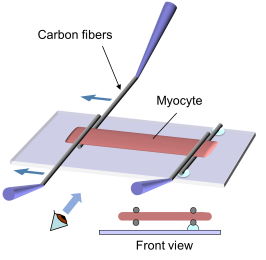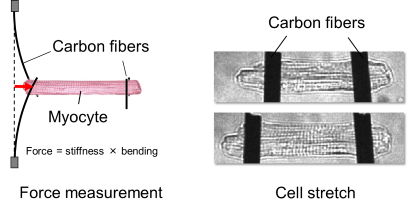Research
Cardiac mechanics study using single isolated cardiomyocytes
Since the heart functions as a mechanical pump to supply blood throughout the body, cardiac mechanics is one of the most basic and important topics in cardiac physiology research. Many cardiac mechano-energetics studies have been actively conducted using whole heart preparations. Although, whole heart preparations are useful in observing integrated mechanical functions, single cell preparations are more advantageous when we need to address roles of subcellular components in the whole heart mechanics. We developed a dynamic force-length control system for single intact cardiomyocytes that uses a pair of compliant, computer-controlled, and piezo translator-positioned carbon fibers. This system allows reproducing mechanical load environment of the "in situ" heart on the single cell preparation. Using this technology, we are conducting research to integrate the mechanical behavior of the heart at the organ level and its intracellular mechanism.


Mechano-sensitive responses in myoicardium
In cardiomyocytes, the electrical excitation initiates mechanical contraction (excitation-contraction coupling). However, mechanical loads also modify electrical activity via, for instance, mechano-sensitiver channels. Therefore, electrical and mechanical activities influence each other in both directions (mechano-electric coupling: MEC). Nowadays, various mechano-sensitive phenomena have been discovered not only in sarcolemmal mechano-sensitive ion channels but also in various intracellular modules including organelles. Since the heart repeats contraction and relaxation, cardiomyocytes are constantly under mechanical load, which is thought to modify cell functions via various intracellular machano-sensitive modules. We are focusing on this physiological environmental factor, "mechanical load" as an input element of the mechanoenergetics control system of the heart and conducting research to elucidate the physiological and pathophysiological significance of mechano-sensitivity.

Electrophysiological experiments under cellular stretch

Stretch-induced increase in calcium spark rate

